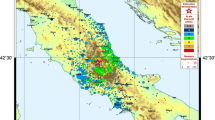Abstract
One essential piece of information used to estimate earthquake casualties is the spatiotemporal distribution of the population. HAZUS-MH is a loss-estimation model nested in a geographic information system that has been developed and freely distributed by the US Federal Emergency Management Agency to estimate loss and damage due to natural hazards. Because inventories of behavioral patterns based on empirical data have not been developed and have relied solely on behavioral information about the US population, they may not provide reliable and meaningful casualty estimations in an international setting. To estimate accurate hourly exposure for an earthquake using empirical data, the study uses a daily time-use survey conducted by Statistics of Korea. The survey contains behavioral data from approximately 21,000 respondents, collected over 24 h. By combining structural damage estimates, calculated by HAZUS-MH, with spatiotemporal behavior patterns estimated using a daily time-behavioral survey in Korea, the study shows the estimated casualties related to a given earthquake scenario in the Ulsan area. The simulation results show that the greatest number of estimated casualties occurred when the earthquake struck between 2 a.m., and 4 a.m. The fewest casualties were expected when the earthquake occurred between 12 p.m., and 2 p.m. The proportion of the indoor population in damaged buildings and the spatial distribution of occupancy type was one of the important factors. During the daytime, casualties increased where the nonresidential occupancy was concentrated. At nighttime, a higher number of casualties were estimated in residential occupancy.








Similar content being viewed by others
References
Allen RM, Gasparini P, Kamigaichi O, Böse M (2009) The status of earthquake early warning around the world: an introductory overview. Seismol Res Lett 80(5):682–693
Federal Emergency Management Agency (FEMA) (2012) Hazus-MH—MH 4.0 earthquake model technical manual. FEMA, Mitigation Division, Washington, DC, Unites States, Federal Emergency Management Agency and National Institute of Building Sciences
Geller RJ (1997) Earthquake prediction: a critical review. Geophys J Int 131(3):425–450
Hansen R, Bausch D (2007) A GIS-based methodology for exporting the hazards US (hazus) earthquake model for global applications. Federal Emergency Management Agency. http://www.hazus.org/HUG%20DOCUMENTS/Global_HAZUS.pdf
Jung T (2001) Comparative study on the attenuation of P and S waves in the crust of the southeastern Korea. J Korean Earth Sci Soc 22(2):112–119
Kamigaichi O (2004) JMA earthquake early warning. J Jpn Assoc Earthq Eng 4(3):134–137
Kang S, Kim K (2011) A simulation of earthquake loss estimation with application of a site classification map. J Korea Soc Hazard Mitig 11(6):67–75
Kang S, Kim K, Suk B, Yoo H (2007) Attenuation relations in HAZUS for earthquake loss estimations in Korea. J Earthq Eng Soc Korea 11(6):15–21
Kim T (2012) State of practice of performance-based seismic design in Korea. In: Proceedings on 2012 Earthquake engineering society of Korea conference, pp 36–55
Kircher CA, Whitman RV, Holmes WT (2006) HAZUS earthquake loss estimation methods. Nat Hazards Rev 7(2):45–59
Korean Statistical Information Service (2010) Korean time use survey. Kostat.go.kr. Retrieved 2012-06-05
Kyung J (2010) Paleoseismological study and evaluation of maximum earthquake magnitude along the Yangsan and Ulsan Fault Zones in the Southeastern Part of Korea. Geophys Geophys Explor 13(3):187–197
Levi T, Tavron B, Katz O, Amit R, Segal D, Hamiel Y, Salamon A (2010) Earthquake loss estimation in Israel using the new HAZUS-MH software: preliminary implementation. Ministry of National Infrastructures Geological Survey of Israel
Neighbors CJ, Cochran ES, Caras Y, Noriega GR (2012) Sensitivity analysis of FEMA HAZUS earthquake model: case study from King County, Washington. Nat Hazards Rev 14(2):134–146
Nyquist C (2012) The USGS and partners work to develop an earthquake early warning system for California. Science Features: Top Story. Retrieved from http://www.usgs.gov/blogs/features/usgs_top_story/the-usgs-brings-an-earthquake-early-warning-system-to-california/
OECD (2013) Average annual hours actually worked per worker. Stats.oecd.org. Retrieved 2015-04-15
Ploeger SK, Atkinson GM, Samson C (2010) Applying the HAZUS-MH software tool to assess seismic risk in downtown Ottawa, Canada. Nat Hazards 53(1):1–20
Remo JW, Pinter N (2012) Hazus-MH earthquake modeling in the central USA. Nat Hazards 63(2):1055–1081
Schmidtlein MC, Shafer JM, Berry M, Cutter SL (2011) Modeled earthquake losses and social vulnerability in Charleston, South Carolina. Appl Geogr 31(1):269–281
Silva V, Crowley H, Pagani M, Monelli D, Pinho R (2014) Development of the openquake engine, the global earthquake model’s open-source software for seismic risk assessment. Nat Hazards 72(3):1409–1427
Sun C, Chun S (2013) A preparatory study on the application of HAZUS for earthquake loss estimation at a coastal facility area in Korea. In: Proceedings on 2013 earthquake engineering society of Korea conference, pp 15–18
Tantala MW, Nordenson GJ, Deodatis G, Jacob K (2008) Earthquake loss estimation for the New York City metropolitan region. Soil Dyn Earthq Eng 28(10):812–835
Ulsan Statistical Information Service (2010) Economic surveys. Ulsan.go.kr. Retrieved 2012-08-11
Wen K-L, Shin T-C, Wu Y-M, Hsiao N-C, Wu B-R (2009) Earthquake early warning technology progress in Taiwan. J Disaster Res 4(4):202–210
World Economic Outlook Database, International Monetary Fund (2013) Gross domestic product per capita. Imf org Retrieved 2013-04-14
Acknowledgments
This work was supported by the Center for Atmospheric Sciences and Earthquake Research of Korea (CATER 2012-5092) and Technology Advancement Research Program (15CTAP-C078783-02) funded by Ministry of Land, Infrastructure, and Transport of Korean government.
Author information
Authors and Affiliations
Corresponding author
Rights and permissions
About this article
Cite this article
Park, JH., Shin, M. & Cho, GH. A dynamic estimation of casualties from an earthquake based on a time-use survey: applying HAZUS-MH software to Ulsan, Korea. Nat Hazards 81, 289–306 (2016). https://doi.org/10.1007/s11069-015-2079-x
Received:
Accepted:
Published:
Issue Date:
DOI: https://doi.org/10.1007/s11069-015-2079-x




